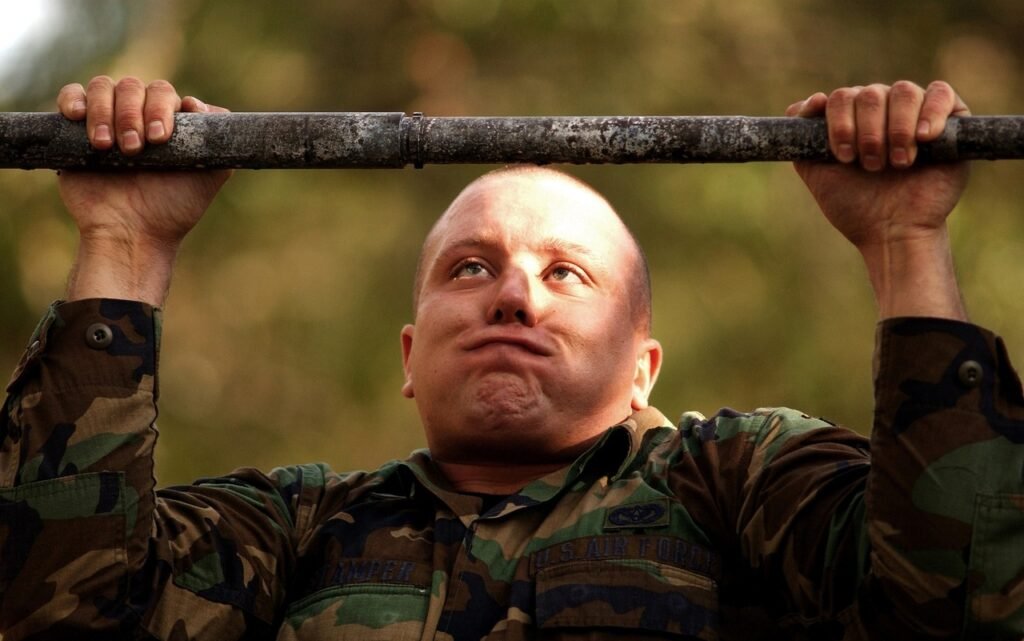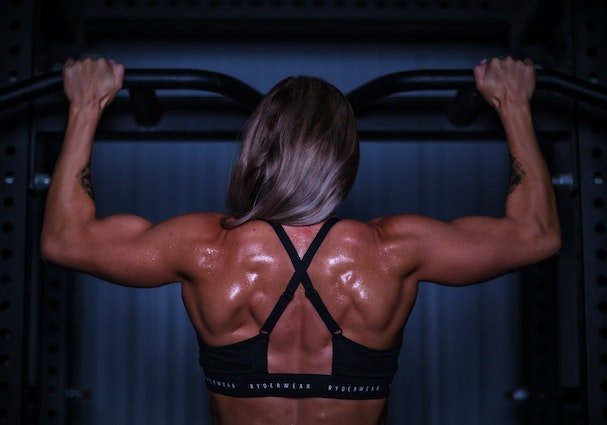
Why Are Pull ups harder than dips? Everything You Need To Know
Have you ever been in the gym doing back exercises and wondered why pull ups seem so much harder than dips?
It’s a question that many of us have pondered, as it can be quite frustrating to feel like progress isn’t being made.
This blog post will delve into the interesting biomechanics that make pull ups more challenging for most people, as well as some effective strategies for how to optimize your strength and form when giving them a try.
Get ready to discover why pull ups are tougher than dips – and just how to begin conquering them!
Why are pull ups harder than dips?
There are a few key differences between pull ups and dips that make them harder to perform. The first difference lies in the muscles involved in each exercise, as dips use primarily triceps, while pull ups require the biceps, lats and forearms to be engaged as well. This makes pull ups more demanding from an energy standpoint, as the body must work harder to generate enough force to lift its entire weight. Stability is another key factor that makes pull ups tougher than dips; not only does your body have to generate a lot of force, but you also need to maintain an optimal grip throughout the exercise in order to maximise stability. This requires more grip strength and range of motion than what is necessary when doing dips. Finally, pull ups are also more challenging due to the unique body mechanics involved. While dips require a linear pushing movement, pull ups involve a more complex vertical pulling motion that can be difficult to master if you’re new to it. Imbalances in strength and form can also reduce your efficiency when performing pull ups, thus making them harder than dips.
Now that you know why pullups are tougher than dips, let’s discuss some strategies for optimizing your form and strength when giving them a try.
Muscles used
The muscles most heavily involved in the performance of pull ups are the biceps, lats and forearms.
Since these muscles need to generate a significant amount of force to lift your entire body weight, it’s important to make sure that you’re engaging all of them as much as possible when performing the exercise.
The muscles used when performing dips are primarily the triceps and your pecs. While these muscles don’t need to generate as much force as the muscles used for pull ups, they still need to be activated in order to maximize your efficiency when performing dips.
Both exercises involve the activation of your core to a certain degree, so make sure that you’re engaging your abs when performing either one.
Both exercises are quite different and involve the use of different muscles, making them more challenging than each other in their own right.
Greater strength
In order to perform pull ups, you need to be able to generate enough force with your biceps, lats and forearms in order to lift your entire body weight.
This can be quite challenging for beginners, as it requires a significant amount of strength in these muscles.
In comparison, dips require less overall force from the muscles involved, as you’re not lifting your entire bodyweight the same way you are with pull ups, due to our body mechanics.
For this reason, dips tend to be easier for those who are just starting out and don’t have the necessary strength yet to perform pull ups effectively.
Greater strength and coordination are key factors in being able to perform pull ups correctly, and are also the main reason why they are harder to do than dips.
Lets not forget, that lifting your entire body weight, no matter what exercise is never going to be easy, unless you are naturally gifted or have trained for a decent amount of time to build your strength.

Stability is a key factor
In addition to the muscles involved, stability is another key factor that makes pull ups harder than dips. Not only do you need to generate enough force with your muscles, but you also need to maintain an optimal grip throughout the exercise in order to maximize stability.
This requires more grip strength and range of motion than what is necessary when doing dips, making pull ups even tougher to perform.
When you think about both exercises, the fact your hands and arms are closer to your body when performing dips compared to pull ups is an added advantage.
For dips, the arms and hands are closer to the center of gravity (torso) making it easier to maintain control when pressing up and down.
With pull-ups however, grip widths will vary between individuals depending on how wide or narrow they can comfortably hold onto a bar.
This greater distance between the arms and hands makes it more difficult to keep balance while performing pull ups, making them harder than dips.
One way to think about this would be attempt dips with your arms the same width as you would have them doing a pull up. You would soon find that the exercise would be a lot more difficult and very dangerous!
Push and pull exercises
The big difference between these two exercises is that pull ups involve a vertical pulling motion, while dips require a linear pushing motion.
This can be quite difficult for someone who is new to either of the exercises, as it requires coordination and balance between your body’s different muscles that may not have been used in this way before.
Your body must learn how to move all of its different muscles together in order to generate the force necessary to perform either of these exercises correctly.
Once you’ve mastered this, both pull ups and dips can become easier over time as your body gets used to the movements required for each exercise.
However, dips are still likely to be easier than pull ups, as they don’t require the same level of coordination and strength that is necessary for pull ups.
Related: Why do my forearms get tight when I do back exercises?
Mechanical leverage
While both exercises involve the use of your body’s natural leverage, pull ups are naturally more challenging due to the greater range of motion involved in the exercise.
This greater range of motion requires your muscles to generate a higher level of force than what is needed for dips, making it harder and more taxing on your body.
Dips require you to push from a starting point with your arms straight, which puts you at a mechanical advantage compared to pull ups.
In addition, dips are done from the chest up, while pull ups require you to lift all the way from the top of your head.
This means that pull ups involve a much longer range of motion and require more strength and coordination to perform correctly.
In comparison, dips require a much smaller range of motion, making them simpler and less stressful on your body.
Taking advantage of the body’s natural motion mechanics, pressing is more comfortable than pulling, making dips easier to execute than pull-ups.
Force generated
Pull ups require a greater level of strength in order to lift your entire bodyweight, whereas dips only require you to push up with your arms straight and generate enough force to get back up.
This makes pull ups more demanding from an energy standpoint, as the body must work harder to generate enough force to lift its entire weight.
In comparison, dips require less force and therefore can be easier on your body’s energy reserves.
While both exercises will still provide a good workout and challenge your muscles, pull ups are significantly more demanding than dips when it comes to the amount of force generated.
Generating enough force to pull your entire body from a hanging position with your arms straight to pulling your body weight past the bar is a difficult task and requires considerable strength and coordination.
So dont get too downbeat if you find pull ups harder than dips, as it is simply a matter of generating enough force and coordination to perform the exercise correctly. Pull ups are a great way to challenge your body and build strength, so keep at it and you’ll eventually get there.
Grip strength
Both pull ups and dips require the use of a strong grip to ensure that you’re able to maintain stability throughout each rep.
A weak grip can lead to form breakdowns which can limit the effectiveness of either exercise.
For this reason, it might be wise to practice grip strength exercises to ensure that your hands and arms stay strong during your workouts.
However, the difference lies in the way each exercise requires you to use your grip.
Dips involve a linear pushing motion which can allow for a relaxed grip and less strain on the forearms compared to pull ups.
Pull ups require a strong grip to hold your body in place while you’re lifting your entire weight.
Therefore, it is likely that pull ups will require more grip strength than dips and could be more taxing on your forearms.

New to you
If you’re new to either exercise, it’s likely that pull ups will be harder than dips.
Your body needs time to get used to the movements required for each exercise, and when you’re starting out, it can take some time for your muscles to become strong enough and coordinated enough to perform pull ups correctly.
Dips, on the other hand, can be a great way to build up your strength and coordination before tackling pull ups.
With consistent practice and dedication, you will eventually be able to perform both exercises with ease. So don’t get too frustrated if you find pull ups harder than dips – it is just a matter of time and practice.
One thing you can do if you are starting out is to use a pull up or dip assist machine to help you with the exercise until your strength and coordination improve. This can make it easier for your body to get used to the movements required for pull ups and dips before trying them without any assistance.
Imbalances
It is important to note that any muscular imbalances or weaknesses you have can affect the difficulty of both pull ups and dips.
For example, if your triceps are weak compared to your biceps, this could make dips harder than pull ups. Similarly, if your shoulder muscles are weak, you’ll find that pull ups will be more difficult than dips.
If you have any muscular imbalances, it’s important to work on these areas to ensure that both exercises are as effective as possible.
Failure to do so will result in failure to progress and can even lead to injuries. If you dont spend time on these areas, you will find pull ups harder than dips and vice versa.
Its important to have a well rounded fitness program that focuses on both pull ups and dips, as well as other exercises that help address any weaknesses or imbalances.
Form
Your form is crucial when it comes to pull ups as well as dips.
If you find yourself struggling with pull ups, it’s worth taking a look at your form and making sure you have a strong grip and proper body alignment throughout each rep.
For dips, make sure that your elbows are close to the body and that you keep your spine neutral to avoid any unnecessary strain on the shoulders and neck.
Pull ups require a lot of control, as your body needs to be in the correct position in order for you to generate enough force, plus you need to make sure the correct muscles are being engaged.
If your form is incorrect, this can make it more difficult to perform both exercises correctly. So its important to practice good form if you want to progress and make sure that pull ups are not harder than dips.
To get your form down, youll need to practice regularly and get feedback from a qualified coach or trainer if needed.
Use resistance bands or assisted machines to help you build your strength and coordination if necessary.
Related: Why do I feel lat pulldowns in my chest?
Training volume
The reason you might find pull ups harder than dips, might be down to the fact you arent training them enough to see any kind of progesss.
Pull ups and dips are both compound exercises, so they require a great deal of energy and effort to perform correctly.
If you’re not training them enough or pushing yourself hard enough when you do train, it will be harder for your body to make the necessary gains in strength and coordination. To see real progress, you need to make sure you’re training pull ups and dips consistently and pushing yourself out of your comfort zone.
So if you find that pull ups are harder than dips, take a look at your training program and make sure that it is well balanced between both exercises. With the right approach, both pull ups and dips will become easier and you will start to see real progress in your strength and coordination.
Everyday living
The final reason why pull ups are harder than dips is that they arent applicable to everyday living.
Pull ups require you to lift your entire body weight and maintain an optimal grip throughout, which can be quite difficult if you’re not used to it, plus as a species we no longer have to climb to get ourselves out of danger or to get food, like we used to many generations ago.
Dips on the other hand are more applicable to everyday life as they involve pushing rather than pulling. This means that dips are better suited to everyday movements such as pushing yourself up off the floor or pushing a heavy object.
So if you find pull ups are harder than dips, take this into consideration and remember that each exercise has its own benefits and applications in everyday life.
Final thoughts…
Pull ups are definitely a tougher exercise than dips, but with the right approach and dedication they can be conquered.
Pay close attention to your form, ensure you have a balanced program and remember to make sure you are spending enough time training the exercise.
Use assisted machines or resistance bands to help build your strength and coordination if necessary.
With a little bit of hard work and dedication you can make great progress with both exercises!
Have you found pull ups harder than dips? Let me know in the comments below.



Nice! thank you so much! Thank you for sharing. Your blog posts are more interesting and informative.
Nice! thank you so much! Thank you for sharing. Your blog posts are more interesting and informative. Check out this article for more information. best chiropractor jersey city